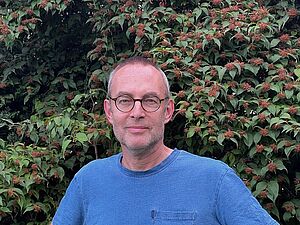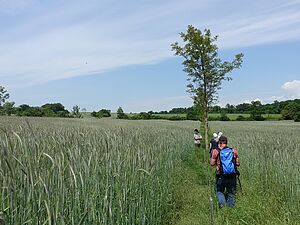"We support companies in the implementation of new concepts"
Voices on biodiversity
Peter Meindl is a biologist and has been working at FiBL Austria for almost two decades. He has been running educational projects on biodiversity promotion for 10 years, supporting farmers in implementing biodiversity-promoting measures with events, informational brochures and films.
In Austria, the agricultural sector is relatively small by European standards. The agricultural area of an average farm is just 32 hectares and around one in four farms is organic (for comparison: Switzerland: around 22 hectares, around one in six farms is organic; Germany: around 65 hectares, around one in seven farms is organic). A good basis for biodiversity-promoting farming, one would think. But even in Austria, biodiversity in the agricultural landscape is declining rapidly. Birds are very well studied and the "Farmland Bird Index" currently shows a downward trend once again. The populations of 23 bird species in the agricultural landscape have been recorded for the index since 1998. The populations of whinchats, skylarks, red-backed shrikes and the like have declined by 40 percent in the last 25 years. The situation is no better for insects and the Red Lists of endangered species are getting longer and longer.
So, what can agriculture do to stop the extinction of species? However, the question is often asked first: Why does agriculture have to do something about it? It is then quickly recognised that our food production is highly dependent on biodiversity. Pollination, pest-benefit relationships or degradation and remodelling processes in the soil are just a few examples where a high level of intact diversity is important.
For many years, one of our goals at FiBL Austria has been to impart knowledge about the importance of biodiversity for agriculture. For example, the transfer of knowledge on the establishment and maintenance of flowering areas - although established and frequently implemented for years - is still an issue. However, the question of how the farm can benefit from a high level of biodiversity is also particularly important. Measures to promote biodiversity affect the economic success of the farm in many ways. A good example of this is the promotion of pollinating insects. In many crops, yields can be significantly increased with the help of wild bees and the like. This is certainly also a motivator for promoting diversity.
Biodiversity and climate change
In addition to the loss of species, climate change is also one of the major challenges facing agriculture in Austria. Concepts for adapting to climate change are therefore being sought, particularly in the dry regions of eastern Austria, in which FiBL is also involved. Agroforestry systems are one possible solution to both crises. The rows of trees on arable land change the microclimate through shade and evaporation and can also protect against water and wind erosion. This is a new concept that FiBL is already supporting farms in implementing in several projects. In addition to climate change adaptation, agroforestry also promotes biodiversity, as the trees bring new habitats and networking elements into the agricultural landscape. Nature and agriculture can therefore benefit in equal measure.
Changes are therefore often initiated by a change in the framework conditions. Whether biodiversity areas, agroforestry or other measures to promote diversity, FiBL Austria supports farms in their implementation. Only with change can we continue to develop agriculture and adapt it to the new challenges.
Further information
Contact
Links
- youtube.com: Video "Agroforst – von der Idee bis zur Umsetzung" (German)
- youtube.com: Video "Blühstreifen im Ackerbau: Saatgut und Anbau" (German)
- bio-net.at: Various publications on flower strips (German)






